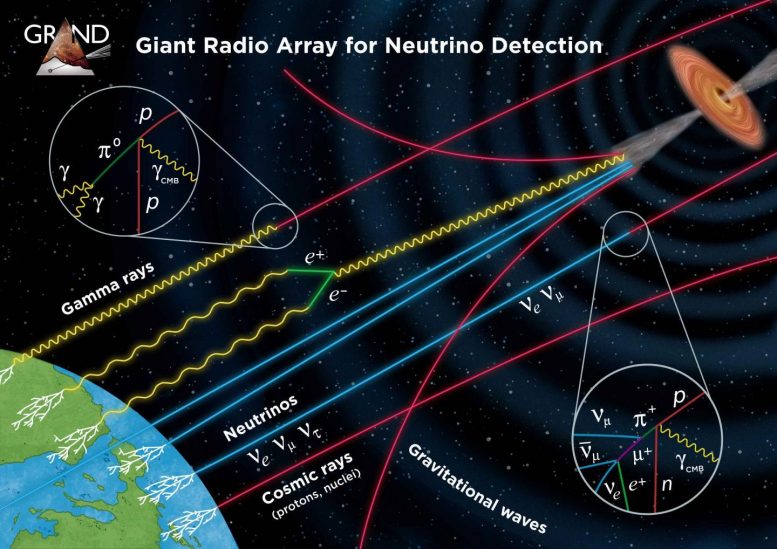
A zero-mass uncharged particle emitted in the process of beta decay. [Trefil, James S.; From Atoms to Quarks - An Introduction to the Strange World of Particle Physics; Charles Scribner's Sons, New York, 1980]
"MIT physicists have found that subatomic particles called neutrinos can be in superposition, without individual identities, when traveling hundreds of miles. Their results, to be published later this month in Physical Review Letters, represent the longest distance over which quantum mechanics has been tested to date.
The team analyzed data on the oscillations of neutrinos - subatomic particles that interact extremely weakly with matter, passing through our bodies by the billions per second without any effect. Neutrinos can oscillate, or change between several distinct "flavors," as they travel through the universe at close to the speed of light." Subatomic Particles "Maintain Ghostly, 'Neither-Here-Nor-There' Identity as They Travel Through Universe"
Neutrinos are among the most abundant particles in the Universe, and yet are hard to detect. They're similar to electrons, but they have no electrical charge and their mass is almost zero, so they interact very Little with normal matter as they stream through the Universe at near light-speed. Billions of neutrinos are zipping through your body right now. Hence, they are also called "ghost particles."
Giant neutrino telescope to open window to ultra-high-energy universe.
The long-sought, elusive ultra-high-energy neutrinos, ghost-like particles that travel cosmological-scale distances, are key to understanding the Universe at the highest energies. Detecting them is challenging, but the Giant Radio Array for Neutrino Detection (GRAND), a next-generation neutrino detector is designed to find them.
A decades-old mystery: where are the most energetic particles coming from?
A major open question in astrophysics for the past fifty years has been the origin of the most energetic particles known to us, the ultra-high-energy cosmic rays (UHECRs). These are electrically charged particles — protons and atomic nuclei — of extraterrestrial origin. Their energies are millions of times higher than those of the Large Hadron Collider.
The most energetic UHECRs have energies of 1019 eV or more. This is about the kinetic energy of a football (soccer ball) kicked by a professional player, concentrated in the size of an atomic nucleus. UHECRs are likely made in powerful cosmic accelerators — like active supermassive black holes and supernovae — located outside the Milky Way, at distances of a few Gigaparsecs (109 parsec ~ 1013 km), in the far reaches of the observable Universe. However, despite our efforts, no individual source of cosmic rays has been identified so far. https://scitechdaily.com/solving-mystery-of-ultra-high-energy-ghost-like-particles-with-next-generation-neutrino-detector/
What happens when a neutrino interacts with something? Depends on what it is they interact with. Neutrinos come in 'flavors', there's the Muon, Electron, and Tau... And, they can oscillate between these flavors. It's like throwing apples at a target and watching as they turn into oranges or lemons on the way before impact.
What they come in contact with an electron, a proton, or other subatomic particle can make them change their flavor as they travel. Very strange particles... [anon]
Three types of neutrinos:
Electron
Muon
Tau
What's the story wrt mass or spin direction for each?
"A neutrino is much lighter than a muon
(2.2 vs 170,000 volts potential )and does not carry electric charge. Therefore, it only interacts through the weak force and it could possibly be its own anti-particle. Just as there are three families of charged leptons (electon, muon, and tau), there are also three different neutrinos."
The mass of electron neutrino is less than 2.2 eV and the mass of muon neutrino is less than 170 KeV.
From the interaction side of view, electron neutrino is created along with the lepton "electron". On the other hand, muon neutrino is created with the lepton "muon". [Warren Walker]
https://neutrino-energy.com/revolutionary-fuel-free.../
Bashar Channeling - Neutrinos and What Our Scientist Are About to Discover | Atomic Physics
https://www.youtube.com/watch?v=UlMekgrJS-4
The flux of neutrinos is several tens of billions per square centimeter per second. Their average velocity is close to the speed of light. Luckily, they barely react with anything so they can pass through the Earth and our bodies quite easily. [anon]
First neutrinos detected at Fermilab short-baseline detector
Scientists working on the Short-Baseline Near Detector at Fermi National Accelerator Laboratory have identified the detector’s first neutrino interactions.
The SBND collaboration has been planning, prototyping and constructing the detector for nearly a decade. And, after a few-months-long process of carefully turning on each of the detector subsystems, the moment they’d all been waiting for finally arrived.
“It isn’t every day that a detector sees its first neutrinos,” said David Schmitz, co-spokesperson for the SBND collaboration and associate professor of physics at the University of Chicago. “We’ve all spent years working toward this moment and this first data is a very promising start to our search for new physics.”
SBND is the final element that completes Fermilab’s Short-Baseline Neutrino (SBN) Program and will play a critical role in solving a decades old mystery in particle physics. Getting SBND to this point has been an international effort. The detector was built by an international collaboration of 250 physicists and engineers from Brazil, Spain, Switzerland, the United Kingdom and the United States.
The Standard Model is the best theory for how the universe works at its most fundamental level. It is the gold standard particle physicists use to calculate everything from high-intensity particle collisions in particle accelerators to very rare decays. But despite being a well-tested theory, the Standard Model is incomplete. And over the past 30 years, multiple experiments have observed anomalies that may hint at the existence of a new type of neutrino.
Neutrinos are the second most abundant particle in the universe. Despite being so abundant, they’re incredibly difficult to study because they only interact through gravity and the weak nuclear force, meaning they hardly ever show up in a detector.
See Also
harmonic current
neutrino oscillation
Neutron
Sympathetic Stream
Undifferentiated Mind
10.05 - The Neutral Zone or Undifferentiated Mind
